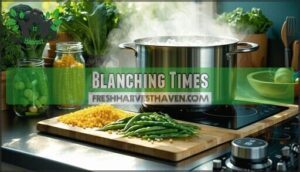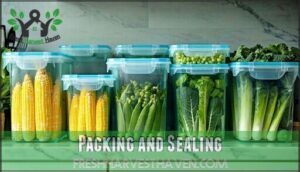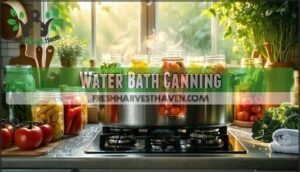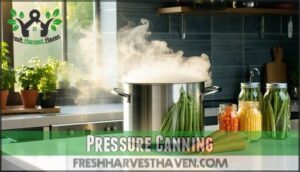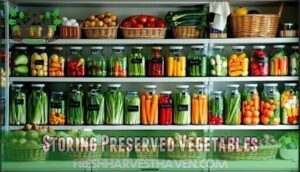This site is supported by our readers. We may earn a commission, at no cost to you, if you purchase through links.
 You can extend your garden’s harvest for months by mastering five proven preservation methods.
You can extend your garden’s harvest for months by mastering five proven preservation methods.
Start by harvesting vegetables at peak ripeness using clean, sharp tools to prevent damage.
Blanch vegetables like green beans for 3-4 minutes before freezing to lock in color and nutrients.
Use water bath canning for high-acid foods like tomatoes, or pressure canning at 240°F for low-acid vegetables.
Electric dehydrators work perfectly at 125°F-135°F for 6-24 hours, creating shelf-stable produce.
Store frozen vegetables at 0°F for 12-18 months, canned goods in cool spaces for 1-5 years, and dehydrated items in airtight containers for up to a decade.
Each method offers distinct advantages depending on your vegetable type and storage goals.
Table Of Contents
- Key Takeaways
- Preserving Garden Vegetables
- Freezing Vegetables
- Canning Garden Produce
- Dehydrating Vegetables
- Storing Preserved Vegetables
- Frequently Asked Questions (FAQs)
- How do you preserve vegetables?
- How do you keep vegetables fresh year-round?
- How do you maintain a healthy vegetable garden?
- How to preserve vegetables for winter?
- How do you keep vegetables ripe?
- How do you keep vegetables from drying out?
- How can I preserve my garden harvests?
- How do you store vegetables in a garden?
- Can you use vegetable oil to preserve fruits and vegetables?
- How long do vegetables last without a refrigerator?
- Conclusion
Key Takeaways
- You’ll master five proven preservation methods – blanching and freezing, water bath canning, pressure canning, dehydrating, and proper storage – to transform your garden’s peak harvest into year-round nutrition.
- Harvest timing and preparation matter most – pick vegetables at peak ripeness using clean tools, handle gently to prevent bruising, and blanch most vegetables for 3-4 minutes before freezing to lock in color and nutrients.
- Each method offers specific storage lifespans – frozen vegetables last 12-18 months at 0°F, canned goods stay fresh 1-5 years in cool spaces, and dehydrated items remain viable up to a decade in airtight containers.
- Proper storage conditions prevent spoilage – use vacuum-sealed bags or airtight containers, label everything with dates, maintain consistent temperatures, and organize your preservation system for easy rotation and access.
Preserving Garden Vegetables
When your garden produces more vegetables than you can eat fresh, proper preservation techniques guarantee nothing goes to waste.
The key to successful preservation starts with harvesting at peak ripeness and preparing vegetables correctly before applying any storage method.
Harvesting Techniques
Harvesting your garden vegetables correctly sets the foundation for successful preservation. Peak ripeness delivers maximum flavor and nutrition, so timing matters more than convenience. Start your ripeness checks early morning when vegetables are crisp and full of moisture.
Harvest at dawn when vegetables reach their flavor peak—timing beats convenience every time
Here’s your harvesting game plan:
- Use sharp, clean harvest tools to prevent disease spread and plant damage
- Handle vegetables gently to avoid bruising that leads to spoilage
- Select firm vegetables that feel solid and show no soft spots
- Choose damage-free crops for long-term storage success
- Stagger your garden harvest through succession planting for continuous picks
Proper handling methods during harvest protect your investment—bruised vegetables won’t store well regardless of preservation technique.
Cleaning and Preparing
Cleaning and preparing your harvest properly prevents spoilage and guarantees preservation success.
Start by rinsing vegetables under cool water, using gentle handling techniques.
For stubborn dirt, employ soft brushes as effective rinse methods. Sort carefully during vegetable inspection, removing damaged items that compromise storage quality.
| Cleaning Step | Method | Purpose |
|---|---|---|
| Initial Rinse | Cool running water | Soil removal |
| Deep Clean | Soft brush scrubbing | Stubborn dirt elimination |
| Final Sanitize | Vinegar solution | Produce sanitizing |
Skip soap completely—use sanitizing solutions like diluted vinegar instead. This vegetable preparation process guarantees spotless produce ready for blanching or immediate preservation.
Proper vegetable storage methods are vital for maintaining freshness and quality.
Selecting Right Vegetables
Smart Vegetable Inspection starts with timing. Fresh Picks require perfect Harvest Timing—catch vegetables at peak ripeness when flavor peaks but texture stays firm.
Your Garden Evaluation should focus on these selection criteria:
- Choose vegetables that feel solid and heavy for their size
- Avoid soft spots, wrinkles, or visible damage anywhere on the surface
- Look for vibrant colors that indicate proper ripeness levels
- Select specimens with intact stems and undamaged skin
- Pick damage-free crops early morning when they’re fully hydrated
Crop Selection matters because bruised vegetables spoil faster during preservation. Sharp, clean tools prevent unnecessary plant damage during harvest. Quality Focus during this stage determines whether your preserving excess garden vegetables efforts succeed or fail months later.
Freezing Vegetables
Freezing vegetables locks in peak-season nutrition and flavor when your garden produces more than you can eat fresh.
You’ll need to blanch most vegetables first to preserve their color, texture, and nutritional value during long-term freezer storage, which helps in maintaining the nutrition.
Blanching Times
Perfect blanching times protect your garden’s hard work from becoming freezer failures. Vegetable blanching requires precision—underblanching won’t achieve enzyme inactivation, while overblanching destroys texture and causes significant nutrient retention loss.
Perfect timing turns garden gold into freezer treasure—precision blanching saves your harvest from winter disappointment
Water temps at boiling point deliver ideal enzyme inhibition when you follow these proven heat times:
- Green beans and asparagus: 3-4 minutes maintains vibrant color and crisp texture
- Broccoli and cauliflower: 3 minutes prevents mushy disappointments
- Corn kernels: 4 minutes locks in natural sweetness
- Spinach and leafy greens: 2 minutes preserves valuable nutrients
Blanching times aren’t suggestions—they’re your insurance policy against wasted vegetables. Set your timer and stick to these intervals for vegetable blanching success that’ll make winter meals taste like summer’s peak ripeness. Using a blanching timer guarantees accurate heat times for superior results.
Packing and Sealing
Three simple steps guarantee your vegetables stay freezer-fresh for months.
Remove air from vacuum-sealed bags or airtight containers to prevent freezer burn.
Use heavy-duty freezer storage bags over flimsy options.
Airtight containers
Label everything with dates—your future self will thank you!
Freezer Storage
After packing your blanched vegetables, proper freezer storage guarantees months of quality preservation. Set your freezer to 0°F (-18°C) for ideal freezer safety and maximum storage duration.
Master these freezer organization techniques:
- Use vacuum-sealed bags or airtight containers to prevent freezer burn on frozen vegetables
- Label everything with dates to track freshness and rotate frozen meals effectively
- Remove all excess air from packages before sealing for better storage tips
- Plan thawing methods ahead – refrigerator thawing works safest for vegetable freezing
Smart freezer storage keeps your freezer-friendly mixes fresh for frozen vegetable recipes year-round. Understanding proper storage conditions is vital for maintaining the quality of your preserved vegetables.
Canning Garden Produce
Canning transforms your garden’s peak harvest into shelf-stable meals that’ll last through winter and beyond.
You’ll use either water bath canning for high-acid foods or pressure canning for low-acid vegetables, ensuring safe preservation that locks in flavor and nutrients.
Water Bath Canning
Although freezing preserves vegetables quickly, water bath canning creates shelf-stable preserves from high-acid foods.
Canning safety demands proper sterilization and acid levels below 4.6 pH. Focus on tomatoes, pickles, and sauces for best results.
Follow tested recipes exactly for correct processing times. Jar sealing techniques guarantee airtight storage.
Proper canning techniques transform your garden excess into pantry staples lasting months.
Pressure Canning
Water bath canning handles acidic foods, but pressure canning tackles low-acid vegetables like green beans, corn, and carrots.
Your pressure canner reaches 240°F, destroying Clostridium botulium spores that cause botulism – something regular boiling water can’t accomplish.
These canning techniques require proper Canner Maintenance and annual Pressure Gauges calibration for accurate readings.
To guarantee safety and efficiency, understanding pressure canner basics is vital.
- Follow processing times exactly and maintain recommended pressure throughout – there’s no room for guesswork when Canning Safety is involved
Sterilization Methods and proven Sealing Techniques guarantee safe food preservation methods for your vegetable canning success.
High-Acid Foods
High-acid foods make canning simpler than pressure methods. Tomato canning, pickled relishes, and fruit preserves naturally contain safe acidity levels below 4.6 pH.
Your preserving techniques for highacid foods include water-bath processing and acidic fermentation.
Preserving harvest through acidic pickling uses vinegar uses effectively.
Canning methods for fruits rely on natural acids, while pickling recipes boost safety.
Always add lemon juice when canning tips suggest it for food preservation methods.
Dehydrating Vegetables
You can transform your garden surplus into shelf-stable nutrition using electric dehydrators or your oven’s lowest setting.
This method concentrates flavors while removing moisture that causes spoilage, giving you crispy vegetables that last months when stored properly.
Electric Dehydrators
Electric dehydrators offer precise temperature control between 125°F and 135°F, preserving up to 80% of vitamin A while removing 90-95% of moisture.
Most dehydrator models feature 4-12 expandable trays that handle large batches efficiently. Energy efficiency averages just $0.14 per hour of operation.
Smart dehydrating food features include:
- Digital controls with automatic timers for consistent results
- Multi-tray systems maximizing batch capacity
- Stackable designs saving counter space
- Even airflow preventing hot spots
Drying times vary from 6-24 hours depending on vegetable thickness and moisture content. Root vegetables like carrots and beets work exceptionally well, while high-moisture produce struggles.
Proper tray management guarantees uniform food dehydration across all levels. Using cold frame gardening techniques can help extend the growing season and provide a steady supply of vegetables for dehydrating.
Low-Temperature Ovens
Don’t have a fancy dehydrator? Your regular oven transforms excess vegetables into shelf-stable treasures. Set your oven to its lowest setting, typically 140-170°F, and prop the door slightly open with a wooden spoon for proper airflow.
This Oven Drying method requires patience but delivers excellent results through controlled Temperature Control and Low Heat application. For the best results, understanding oven dehydrator techniques is vital.
Slice vegetables uniformly and arrange on parchment-lined baking sheets. Check progress every hour, rotating trays for even dehydration. This Slow Cooking approach to vegetable preservation takes longer than electric units but costs nothing extra.
| Vegetable | Drying Time |
|---|---|
| Tomatoes | 6-12 hours |
| Peppers | 8-14 hours |
| Zucchini | 10-16 hours |
| Mushrooms | 6-10 hours |
| Herbs | 2-4 hours |
These Dehydration Methods work perfectly for preserving excess garden vegetables when space runs tight.
Storage Methods
Proper storage transforms your dehydrated vegetables from garden excess into year-round treasures. After dehydrating, pack vegetables in airtight containers or use vacuum sealing to eliminate moisture and air exposure. Glass jars work exceptionally well for vegetable storage, while mylar bags provide lightweight alternatives.
Store containers in cool storage areas like pantries, maintaining 60-70°F temperatures. Unlike root cellars that use moist sand for fresh vegetables, dehydrated produce needs bone-dry conditions. Label everything with harvest dates—you’ll thank yourself later when deciding which tomatoes to use first.
- Glass mason jars with tight-fitting lids prevent moisture infiltration
- Vacuum-sealed bags remove air that causes nutrient degradation
- Mylar bags with oxygen absorbers extend shelf life substantially
- Cool, dark pantry locations maintain ideal storage temperatures
- Regular inspection catches problems before they spread
Storing Preserved Vegetables
Once you’ve preserved your garden vegetables using various methods, proper storage becomes critical to maintain their quality and safety.
Your frozen, canned, and dehydrated vegetables need specific storage conditions to prevent spoilage and maximize their shelf life.
Freezer Organization
Your freezer deserves better than vegetable chaos. Storage bins with freezer labels transform disorder into organized efficiency.
Create a frozen inventory list and stick it on your freezer door—you’ll thank yourself later.
Practice shelf management by stacking freezer bags strategically, keeping frequently used items at eye level.
Regular cooler maintenance prevents temperature fluctuations that destroy your hard work.
Smart freezer organization means freezerfriendly mixes stay fresh longer.
Canned Goods Storage
Keep your canning success story going strong with smart canned goods storage practices. Your carefully preserved vegetables need proper homes to maintain their quality and safety over time.
Smart organization and consistent conditions protect your investment in time and effort. Store glass containers in cool, dark locations away from temperature fluctuations that can compromise food preservation techniques.
Essential storage tips for maximum shelf life:
- Label container labels with contents and processing dates clearly
- Rotate inventory management using oldest jars first
- Check canning jars regularly for damaged lids or cracks
- Maintain storage areas between 50-70°F consistently
- Keep storage spaces clean and moisture-free
Canning safety depends on proper storage conditions after processing. Food storage containers should remain undisturbed in stable environments. Your preserved vegetables will reward careful attention with reliable nutrition throughout the year, ensuring your canning success and maintaining the quality of your carefully preserved vegetables.
Dehydrated Vegetable Storage
Unlike canned goods that sit happily on shelves, dehydrated vegetable storage requires different attention. Moisture control becomes your greatest ally in food preservation success.
Store your dehydrated vegetables in airtight containers away from sunlight to maximize shelf life. A cool pantry works perfectly—you’re looking at years of storage, not months.
Shelf Life
Proper humidity levels and root cellar management are vital for maintaining the quality of stored vegetables.
Label everything with dates and rehydration methods. These storage tips guarantee dehydration efficiency pays off when you need quick soup ingredients on busy weeknights.
Frequently Asked Questions (FAQs)
How do you preserve vegetables?
Vegetables can be preserved through multiple methods: freezing, canning, dehydrating, and fermenting.
You’ll blanch most vegetables before freezing, use proper sterilization for canning, and guarantee adequate airflow when drying for superior results.
How do you keep vegetables fresh year-round?
Consider Sarah’s pantry in February—filled with crisp frozen beans, tangy fermented carrots, and canned tomatoes from last summer’s harvest.
You’ll maintain year-round freshness through blanching before freezing, proper canning techniques, fermentation, and root cellar storage conditions.
How do you maintain a healthy vegetable garden?
Test your soil pH regularly and amend with compost.
Water deeply but infrequently, mulch around plants, and rotate crops annually.
Practice companion planting, remove weeds promptly, and inspect plants weekly for pests or disease signs.
How to preserve vegetables for winter?
Blanch, freeze, and can your harvest using proven techniques.
You’ll blanch green vegetables for 3-4 minutes, then freeze in airtight containers.
Can high-acid foods using water bath methods, while low-acid vegetables need pressure canning for safety.
How do you keep vegetables ripe?
Harvest vegetables at their peak ripeness, then store them properly using cool temperatures, proper ventilation, and appropriate humidity levels to maintain freshness and prevent premature spoilage.
How do you keep vegetables from drying out?
Many gardeners worry vegetables will wilt despite careful storage, but proper hydration prevents this.
Store freshly harvested vegetables in perforated plastic bags with damp paper towels, maintaining humidity while allowing airflow for ideal freshness.
How can I preserve my garden harvests?
You’ll want to choose from several reliable methods: freezing works great after blanching most vegetables for 2-4 minutes.
Canning preserves low-acid veggies using pressure canners, while dehydrating concentrates flavors perfectly for storage.
How do you store vegetables in a garden?
Like grandma’s root cellar wisdom, you’ll store garden vegetables by choosing appropriate locations for each type.
Root crops thrive in cool, humid conditions while winter squash prefers dry, ventilated spaces at 50-55°F.
Can you use vegetable oil to preserve fruits and vegetables?
You can’t safely preserve fruits and vegetables in vegetable oil alone.
Oil lacks the acidity needed to prevent dangerous bacteria growth.
Instead, you’ll need proper canning methods, freezing, or dehydrating for safe preservation.
How long do vegetables last without a refrigerator?
Without refrigeration, most fresh vegetables last 1-7 days depending on type and storage conditions.
Hardy vegetables like potatoes, onions, and winter squash can last weeks or months when stored properly in cool, dark places, which makes them a hardy choice for longer storage.
Conclusion
Successfully preserving excess garden vegetables transforms seasonal abundance into year-round nourishment, reduces food waste, and maximizes your garden’s value.
Whether you choose freezing for convenience, canning for shelf stability, or dehydrating for long-term storage, each method offers unique benefits.
You’ll extend your harvest’s lifespan from days to years while maintaining nutritional quality.
With proper techniques and storage conditions, preserving excess garden vegetables becomes an essential skill that connects you to traditional food preservation wisdom while meeting modern kitchen demands, providing year-round nourishment.

